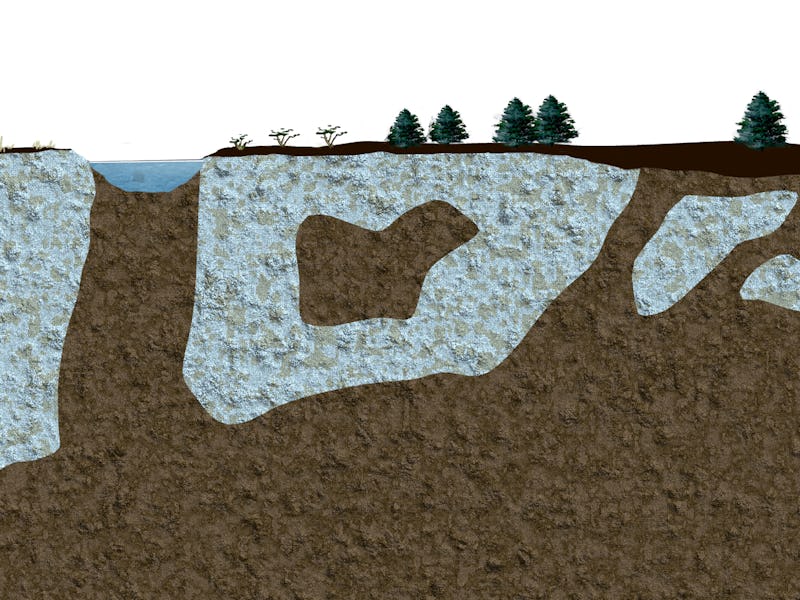Melting permafrost linked to impending environmental disaster — study
A phenomenon could add 40 billion tons of carbon to the atmosphere by the year 2100.

Scientists are worried about melting Arctic permafrost. When permanently frozen ground turns out to be not so permanent, structures built on permafrost can catastrophically collapse — and the bizarre, ranging from abandoned nuclear waste to anthrax, can be revealed.
Now, there's another issue to be concerned about: A massive release of carbon dioxide.
What part of the Covid-19 pandemic do you think causes the most confusion? We want to know. Take the Inverse reader survey
In a natural effect called rhizosphere priming, the roots of plants accelerate the rate of decomposition in soil microbes — which, in turn, releases carbon dioxide. It's no small feature: This effect can increase decomposition fourfold. Still, current climate projections don't explicitly account for rhizosphere priming.
In a new study, researchers did the math and determined that the phenomenon could add 40 billion tons of carbon to the atmosphere by the year 2100. This finding was published Monday in the journal Nature Geoscience.
That means humans need to cut greenhouse gas emissions even more than expected, say the study authors. Prior to this study, scientists estimated that global emissions must fall by 7.6 percent every year over the next 10 years to meet the 1.5°C temperature goal of the Paris Agreement.
The effect of rhizosphere priming, the research team writes, is "currently unaccounted for in global emission scenarios and implies that the remaining anthropogenic carbon budget to keep warming below 1.5 or 2 °C ... may need to be even more constrained."
Permafrost is vital to the world's climate because it stores twice as much carbon as there is in the atmosphere. Under usual circumstances, the top layer of the frozen soil thaws during summer, when plants and microorganisms spring to life. The microbes munch on plant roots and inevitably emit greenhouse gases since they have to respirate to live.
Researchers illustrate how rhizosphere priming increases soil microbe respiration.
This effect creates a feedback loop: More melting soil means there are more plant roots to feed hungry microbes, which warm the atmosphere simply by existing.
The priming effect isn't new. Scientists have been aware of it since the 1950s. What they didn't know was how this micro-scale ecology would contribute to global carbon emissions.
To figure that out, the researchers mapped plant and soil data across permafrost ecosystems, discovering that priming alone can increase respiration among soil microbes by 12 percent.
That translates to 40 billion tons of additional carbon that will be released in the coming 80 years — more than the amount the entire planet releases each year.
"These new findings demonstrate how important it is to consider small-scale ecological interactions, such as the priming effect, in global greenhouse gas emission modeling," study co-author Birgit Wild, an assistant professor at Stockholm University, explained in a statement.
The danger of Arctic warming — While all of Earth is heating up, warming is significantly worse in the Arctic.
The past decade was the hottest on record overall, suggests analyses by NASA and the National Oceanic and Atmospheric Administration. In the Arctic, air temperatures are rising twice as fast as the global average.
This new study shows that permafrost melt can, in turn, prompt further melt: More carbon in the atmosphere means worsened atmospheric warming, which means more melting.
We're already seeing this in action: In late June, a summer heatwave in Siberia contributed to widespread wildfires on frozen land. The fires released a record-breaking amount of carbon dioxide, with 18 million hectares of forest burning up. Scientists warn these fires could lead to more thawing of Arctic permafrost.
Abstract: As global temperatures continue to rise, a key uncertainty of climate projections is the microbial decomposition of vast organic carbon stocks in thawing permafrost soils. Decomposition rates can accelerate up to fourfold in the presence of plant roots, and this mechanism—termed the rhizosphere priming effect—may be especially relevant to thawing permafrost soils as rising temperatures also stimulate plant productivity in the Arctic. However, priming is currently not explicitly included in any model projections of future carbon losses from the permafrost area. Here, we combine high-resolution spatial and depth-resolved datasets of key plant and permafrost properties with empirical relationships of priming effects from living plants on microbial respiration. We show that rhizosphere priming amplifies overall soil respiration in permafrost-affected ecosystems by ~12%, which translates to a priming-induced absolute loss of ~40 Pg soil carbon from the northern permafrost area by 2100. Our findings highlight the need to include fine-scale ecological interactions in order to accurately predict large-scale greenhouse gas emissions, and suggest even tighter restrictions on the estimated 200 Pg anthropogenic carbon emission budget to keep global warming below 1.5 °C.
This article was originally published on